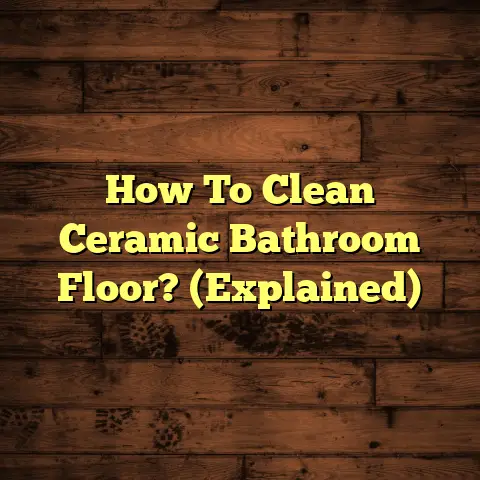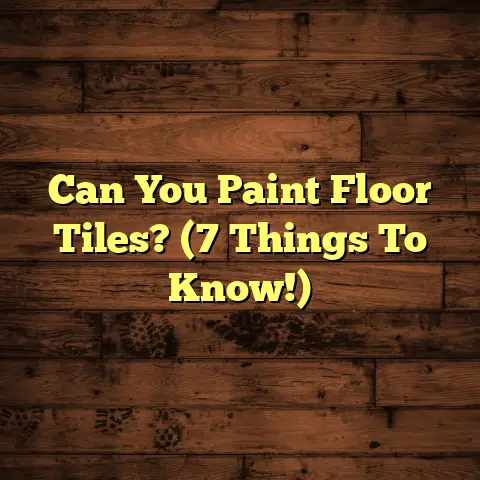How To Polish Limestone Floor Tiles? (Explained)
Polishing limestone floor tiles is a popular task for homeowners looking to maintain the beauty and longevity of their flooring. As a flooring contractor with years of experience, I’ve had my fair share of working with various materials, but limestone holds a special place in my heart. It’s not only aesthetically pleasing but also offers a pet-friendly choice for households with furry companions. If you have pets like I do, you understand the need for materials that can withstand daily wear and tear while remaining stylish and inviting.
Understanding Limestone Flooring
Limestone tiles are known for their unique textures and natural colors. However, they are also porous, which means they can be susceptible to staining and scratching. This is why proper care and polishing are essential to keep them looking pristine. I remember the first time I installed limestone tiles in my own home; they added a touch of elegance to the space. However, I quickly realized that maintaining their shine required regular attention.
The Beauty of Limestone
Limestone comes in various colors and finishes, making it versatile for different design styles. Whether you prefer a rustic look or a more modern aesthetic, limestone can complement your home beautifully. Its natural appearance provides warmth and character, adding value to your property.
Preparing for the Polishing Process
Before starting the polishing process, gathering the right materials and tools is crucial. Here’s a list of what you’ll need:
- Mild pH-neutral cleaner: Avoid harsh chemicals that can damage the stone.
- Soft mop or cloth: For cleaning before polishing.
- Diamond polishing pads: These are essential for achieving a smooth finish.
- Water: For rinsing and lubrication during polishing.
- Sealer: After polishing, applying a sealer protects the tiles.
When I first polished my limestone floors, I jumped in without thoroughly cleaning them first. The result? A less-than-stellar shine that left me feeling frustrated. Cleaning the floor properly beforehand makes all the difference.
Step-by-Step Polishing Process
1. Cleaning the Floor
Start by sweeping or vacuuming the floor to remove dirt and debris. Then, mix your pH-neutral cleaner with water according to the manufacturer’s instructions and mop the floor. Rinse with clean water to ensure no residue is left behind.
2. Assessing the Floor Condition
Take a close look at your tiles. If you notice deep scratches or stains, you might need to do some extra work before polishing. I’ve encountered limestone floors that required grinding to remove stubborn stains. It was a labor-intensive process but worth it in the end.
3. Using Diamond Polishing Pads
Once your floor is clean and dry, it’s time to polish. Attach a diamond polishing pad to your floor buffer. I typically start with a lower grit (around 200) for heavy-duty polishing and gradually work my way up to a higher grit (around 3000) for a glossy finish.
Be sure to keep the pad wet while working; this helps prevent dust and keeps the surface cool. I’ve made the mistake of letting the pad dry out, which only created more work for me later.
4. Buffing the Floor
Work in small sections, using overlapping passes to ensure even coverage. Spend more time on areas that may need extra attention, like high-traffic spots. It’s like giving your floors a mini spa treatment!
5. Rinsing and Drying
After buffing, rinse the floor with clean water to remove any residue from the polishing process. Then, dry it off with a soft mop or cloth.
6. Applying Sealer
Once the floor is completely dry, apply a high-quality sealer designed for limestone. This step is crucial for protecting your floors from stains and keeping them looking beautiful longer.
Challenges I’ve Faced
While polishing limestone might sound straightforward, I’ve encountered challenges along the way. One significant issue was dealing with etching caused by acidic spills—like lemon juice or vinegar—on unsealed tiles. In these cases, I had to assess whether grinding was necessary or if I could simply polish over it.
Another challenge was ensuring that the sealer applied evenly. The first time I sealed my floors, I rushed through it and ended up with streaks. Now, I take my time applying sealer in thin layers, allowing each layer to dry before adding another.
Tips for Success
- Regular Maintenance: Incorporate regular cleaning into your routine to prevent dirt buildup.
- Use Doormats: Placing doormats at entrances can help minimize dirt tracked onto your floors.
- Avoid Harsh Chemicals: Stick with mild cleaners that won’t harm your limestone.
- Test Products First: Always test new products in an inconspicuous area to avoid surprises.
Cost Estimation with FloorTally
When taking on flooring projects, cost estimation is a big part of my process. FloorTally has been incredibly helpful in generating accurate estimates based on local material and labor rates. I remember working on a project where we had to budget for polishing limestone tiles across multiple rooms. With FloorTally’s detailed breakdown, I was able to provide my clients with clear insights into costs associated with labor, materials, and additional services like sealing.
This tool saved me hours of calculating and allowed me to focus on other aspects of the project while ensuring my clients felt informed and confident in their choices.
Types of Limestone Finishes
Limestone comes in various finishes that affect its appearance and maintenance requirements. Here are some common finishes I’ve encountered in my work:
Honed Finish
A honed finish is smooth but not glossy. It offers a matte appearance that’s great for hiding scratches but requires regular sealing to prevent staining.
Polished Finish
A polished finish provides a shiny surface that reflects light beautifully. While it enhances the stone’s color depth, it can show scratches more easily than other finishes.
Tumbled Finish
A tumbled finish gives limestone a rustic look with rounded edges and a textured surface. It’s slip-resistant but may require more frequent cleaning due to its texture.
Dealing with Stains
Stains on limestone can be frustrating, especially if you don’t know how to tackle them effectively. Over the years, I’ve learned several techniques for dealing with common stains:
Oil-Based Stains
For oil-based stains, like cooking oil or grease, sprinkle baking soda on the stain and cover it with plastic wrap overnight. The baking soda will absorb the oil, making it easier to clean.
Water Stains
Water stains can often be removed by using a mixture of hydrogen peroxide and flour to create a paste. Apply this paste to the stain, cover it with plastic wrap, and let it sit for 24 hours before rinsing.
Acidic Stains
Acidic substances like vinegar can etch limestone surfaces. If you notice etching, you might need to use a diamond grinding pad before polishing to remove the damage.
Preventing Future Damage
Preventing damage to your limestone floors is just as important as maintaining their shine. Here are some strategies I’ve found effective:
- Immediate Cleanup: Wipe up spills as soon as they occur to prevent staining.
- Use Coasters: For beverages or any acidic items, always use coasters.
- Regular Sealing: Reapply sealer every 6-12 months depending on foot traffic and usage.
The Benefits of Regular Polishing
Regular polishing not only enhances the appearance of your limestone floors but also extends their lifespan. I’ve noticed that clients who commit to regular polishing enjoy fewer issues with scratches and stains over time. Plus, polished floors are easier to clean since dirt doesn’t cling as stubbornly.
Comparing Limestone Care Products
Over the years, I’ve tried various cleaning products and sealers specifically designed for limestone care. Here’s a comparison based on my experiences:
Product A: Brand X Limestone Cleaner
- Pros: Effective at breaking down grime; easy to use; pleasant scent.
- Cons: Slightly higher price point compared to competitors.
Product B: Brand Y Sealer
- Pros: Long-lasting protection; minimal reapplication required.
- Cons: Takes longer to dry; requires careful application.
Based on my experience, mixing different products can yield excellent results—Brand X cleaner followed by Brand Y sealer worked wonders on my floors!
Conclusion
Polishing limestone floor tiles may seem daunting at first, but with the right tools and techniques, it can be an enjoyable process that results in stunning floors. From cleaning and assessing to polishing and sealing, each step plays a crucial role in achieving beautiful finishes.
In my experience, maintaining limestone floors requires diligence but pays off in elegance and durability—especially in homes with pets. Remember to embrace the journey of caring for your floors; after all, each step brings you closer to enjoying their beauty every day!
With regular care and attention, your limestone floors will remain an attractive feature of your home for many years to come. So grab your supplies and get started on that polishing project—you won’t regret it!





